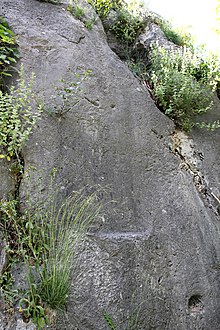

Mursili III
| |
|---|---|
| Other names | Urhi-Teshub |
| Title | King of the Hittites |
| Predecessor | Muwatalli II |
| Successor | Hattusili III |
| Parent | King Muwatalli II |
| Relatives | Tudhaliya IV (cousin) |
Mursili III, also known as Urhi-Teshub, was a king of the Hittites who assumed the throne of the Hittite empire (New Kingdom) at Tarhuntassa upon his father's death. He was a cousin of Tudhaliya IV and Queen Maathorneferure. He ruled ca. 1282–1275 BC (middle chronology)[1] or 1272–1265 BC (short chronology).
He was the eldest surviving son of Muwatalli II. He was a grandson of Mursili II.
During his reign, Mursili III reverted the capital from Tarhuntassa (as it had been under Muwatalli) back to Hattusa (KBo 21.15 i 11-12). However, the Assyrians captured Hanigalbat, which severely weakened his legitimacy to rule over the Hittite Empire. In his seventh year, Mursili III attacked and seized control of his uncle Hattusili's regional strongholds of Hakpissa and Nerik within the Hittite Empire in order to remove Hattusili as a threat to the throne. Hakpissa served as the centre of Hattusili's power while Nerik was under Hattusilis's sway from the latter's position as high priest there. Hattusili then states in a well-known text:
"For seven years I submitted [to the king]. But at a divine command and with human urging, Urhi-Tesub sought to destroy me. He took Hakpissa and Nerik from me. Now I submitted to him no longer. I made war against him. But I committed no crime in doing so, by rising up against him with chariots or in the palace. In civilised manner I communicated thus with him: 'You have begun hostilities with me. Now you are Great King, but I am king of only one fortress. That is all you have left me. Come! Istar of Samuha and the Storm God of Nerik shall decide the case for us!' Since I wrote to Urhi-Tesub in this manner, if anyone now says: 'Why after previously making him king do you now write to him about war?' (my reply would be); 'If he had not begun fighting with me, would Istar and the Storm God have now subjected him to a small king?' Because he began fighting with me, the gods have subjected him to me by their judgement." (Apol. §10C, III 63-79)[2]
Consequently, Mursili III's reign was seven years. In the subsequent revolt, Hatusilli gathered a considerable force. This included natural allies from his local strongholds of Nerik and Hakpissa, as well as many non-aligned Hittites who were impressed with his record of service to the Hittite Empire. His strategic military victory over Ramesses II of Egypt in the 1274 BC Battle of Kadesh was favourably contrasted with the rather "undistinguished and largely unproven occupant of the throne of Hattusa" – Urhi-Teshub/Mursilis III – who had lost Hanigalbat to Assyria in his reign.[3] Hattusili's forces even included elements of the Kaska peoples who were sworn enemies of the Hittites.[4] Hatusilli quickly defeated Mursili III and seized the throne from his nephew; he then succeeded to power as King Hattusili III. After his victory, Hattusili appointed Mursili's brother or brother-in-law, Kurunta, as the vassal king over Tarhuntassa in order to win the latter's loyalty.

Located near the village of Sirkeli Höyük, there's a well known relief of Muwatalli II. A second, very similar relief was just a few meters away, but it was largely destroyed in antiquity. The nature of the damage indicates a deliberate destruction, so that the name of this figure could not be read. Nevertheless, it is believed to have been the relief of Mursili III, destroyed by his uncle as an act of Damnatio memoriae (condemnation of memory).[5]
Mursili fled to Egypt, the land of his country's enemy, after the failure of his plots to oust his uncle from the throne. Hattusili III responded to this event by demanding that Ramesses II extradite his nephew back to Hatti.
This letter precipitated a crisis in relations between Egypt and Hatti when Ramesses denied any knowledge of Mursili's whereabouts in his country and the two empires came dangerously close to war. However, both kings eventually decided to resolve the issue by making peace in Year 21 of Ramesses II. An extradition clause was also included in the treaty. Mursili III soon thereafter disappears from history after his sojourn in Egypt.
Mursili III seemingly had a son. A certain Hartapu calls himself a great king and son of the great king Mursili, who normally is identified with Mursili III. Hartapu likely has ruled Tarhuntassa in the 2nd half of the 13th century BC.[6]
|
Hittite New Kingdom royal family tree according to Trevor Bryce
| ||||||||||||||||||||||||||||||||||||||||||||||||||||||||||||||||||||||||||||||||||||||||||||||||||||||||||||||||||||||||||||||||||||||||||||||||||||||||||||||||||||||||||||||||||||||||||||||||||||||||||||||||||||||||||||||||||||||||||||||||||||||||||||||||||||||||||||||||||||||||||||||||||||||||||||||||||||||||||||||||||||||||||||||||||||||||||||||||||||||||||||||||||||||||||||||||||||||||||||||||||||||||||||||||||||||||||||||||||||||||||||||||||||||||||||||||||||||||||||||||||||||||||||||||||||||||||||||||||||||||||||||||||||||||||||||||||||||||||||||||||||||||||||||||||||||||||||||||||||||||||||||||||||||||||||||||||||||||||||||||||||||||||||||||||||||||||||||||||||||||||||||||||||||||||||||||||||||||||||||||||||||||||||||||||||||||||||||||||||||||||||||||||||||||||||||||||||||||||||||||||||||||||||||||||||||||||||||||||||||||||||||||||||||||||||||||||||||||||||||||||||||||||||||||||||||||||||||||||||||||||||||||||||||||||||||||||||||||||||||||||||||
|---|---|---|---|---|---|---|---|---|---|---|---|---|---|---|---|---|---|---|---|---|---|---|---|---|---|---|---|---|---|---|---|---|---|---|---|---|---|---|---|---|---|---|---|---|---|---|---|---|---|---|---|---|---|---|---|---|---|---|---|---|---|---|---|---|---|---|---|---|---|---|---|---|---|---|---|---|---|---|---|---|---|---|---|---|---|---|---|---|---|---|---|---|---|---|---|---|---|---|---|---|---|---|---|---|---|---|---|---|---|---|---|---|---|---|---|---|---|---|---|---|---|---|---|---|---|---|---|---|---|---|---|---|---|---|---|---|---|---|---|---|---|---|---|---|---|---|---|---|---|---|---|---|---|---|---|---|---|---|---|---|---|---|---|---|---|---|---|---|---|---|---|---|---|---|---|---|---|---|---|---|---|---|---|---|---|---|---|---|---|---|---|---|---|---|---|---|---|---|---|---|---|---|---|---|---|---|---|---|---|---|---|---|---|---|---|---|---|---|---|---|---|---|---|---|---|---|---|---|---|---|---|---|---|---|---|---|---|---|---|---|---|---|---|---|---|---|---|---|---|---|---|---|---|---|---|---|---|---|---|---|---|---|---|---|---|---|---|---|---|---|---|---|---|---|---|---|---|---|---|---|---|---|---|---|---|---|---|---|---|---|---|---|---|---|---|---|---|---|---|---|---|---|---|---|---|---|---|---|---|---|---|---|---|---|---|---|---|---|---|---|---|---|---|---|---|---|---|---|---|---|---|---|---|---|---|---|---|---|---|---|---|---|---|---|---|---|---|---|---|---|---|---|---|---|---|---|---|---|---|---|---|---|---|---|---|---|---|---|---|---|---|---|---|---|---|---|---|---|---|---|---|---|---|---|---|---|---|---|---|---|---|---|---|---|---|---|---|---|---|---|---|---|---|---|---|---|---|---|---|---|---|---|---|---|---|---|---|---|---|---|---|---|---|---|---|---|---|---|---|---|---|---|---|---|---|---|---|---|---|---|---|---|---|---|---|---|---|---|---|---|---|---|---|---|---|---|---|---|---|---|---|---|---|---|---|---|---|---|---|---|---|---|---|---|---|---|---|---|---|---|---|---|---|---|---|---|---|---|---|---|---|---|---|---|---|---|---|---|---|---|---|---|---|---|---|---|---|---|---|---|---|---|---|---|---|---|---|---|---|---|---|---|---|---|---|---|---|---|---|---|---|---|---|---|---|---|---|---|---|---|---|---|---|---|---|---|---|---|---|---|---|---|---|---|---|---|---|---|---|---|---|---|---|---|---|---|---|---|---|---|---|---|---|---|---|---|---|---|---|---|---|---|---|---|---|---|---|---|---|---|---|---|---|---|---|---|---|---|---|---|---|---|---|---|---|---|---|---|---|---|---|---|---|---|---|---|---|---|---|---|---|---|---|---|---|---|---|---|---|---|---|---|---|---|---|---|---|---|---|---|---|---|---|---|---|---|---|---|---|---|---|---|---|---|---|---|---|---|---|---|---|---|---|---|---|---|---|---|---|---|---|---|---|---|---|---|---|---|---|---|---|---|---|---|---|---|---|---|---|---|---|---|---|---|---|---|---|---|---|---|---|---|---|---|---|---|---|---|---|---|---|---|---|---|---|---|---|---|---|---|---|---|---|---|---|---|---|---|---|---|---|---|---|---|---|---|---|---|---|---|---|---|---|---|---|---|---|---|---|---|---|---|---|---|---|---|---|---|---|---|---|---|---|---|---|---|---|---|---|---|---|---|---|---|---|---|---|---|---|---|---|---|---|---|---|---|---|---|---|---|---|---|---|---|---|---|---|---|---|---|---|---|---|---|---|---|---|---|---|---|---|---|---|---|---|---|---|---|---|---|---|---|---|---|---|---|---|---|---|---|---|---|---|---|---|---|---|---|---|---|---|---|---|---|---|---|---|---|---|---|---|---|---|---|---|---|---|---|---|---|---|---|---|---|---|---|---|---|---|---|---|---|---|---|---|---|---|---|---|---|---|---|---|---|---|---|---|---|---|---|---|---|---|---|---|---|---|---|---|---|---|---|---|---|---|---|---|---|---|---|---|---|---|---|---|---|---|---|---|---|---|---|---|---|---|---|---|---|---|---|---|---|---|---|---|---|---|---|---|---|---|---|---|---|---|---|---|---|---|---|---|---|---|---|---|---|---|---|---|---|---|---|---|---|---|---|
| ||||||||||||||||||||||||||||||||||||||||||||||||||||||||||||||||||||||||||||||||||||||||||||||||||||||||||||||||||||||||||||||||||||||||||||||||||||||||||||||||||||||||||||||||||||||||||||||||||||||||||||||||||||||||||||||||||||||||||||||||||||||||||||||||||||||||||||||||||||||||||||||||||||||||||||||||||||||||||||||||||||||||||||||||||||||||||||||||||||||||||||||||||||||||||||||||||||||||||||||||||||||||||||||||||||||||||||||||||||||||||||||||||||||||||||||||||||||||||||||||||||||||||||||||||||||||||||||||||||||||||||||||||||||||||||||||||||||||||||||||||||||||||||||||||||||||||||||||||||||||||||||||||||||||||||||||||||||||||||||||||||||||||||||||||||||||||||||||||||||||||||||||||||||||||||||||||||||||||||||||||||||||||||||||||||||||||||||||||||||||||||||||||||||||||||||||||||||||||||||||||||||||||||||||||||||||||||||||||||||||||||||||||||||||||||||||||||||||||||||||||||||||||||||||||||||||||||||||||||||||||||||||||||||||||||||||||||||||||||||||||||||
| ||||||||||||||||||||||||||||||||||||||||||||||||||||||||||||||||||||||||||||||||||||||||||||||||||||||||||||||||||||||||||||||||||||||||||||||||||||||||||||||||||||||||||||||||||||||||||||||||||||||||||||||||||||||||||||||||||||||||||||||||||||||||||||||||||||||||||||||||||||||||||||||||||||||||||||||||||||||||||||||||||||||||||||||||||||||||||||||||||||||||||||||||||||||||||||||||||||||||||||||||||||||||||||||||||||||||||||||||||||||||||||||||||||||||||||||||||||||||||||||||||||||||||||||||||||||||||||||||||||||||||||||||||||||||||||||||||||||||||||||||||||||||||||||||||||||||||||||||||||||||||||||||||||||||||||||||||||||||||||||||||||||||||||||||||||||||||||||||||||||||||||||||||||||||||||||||||||||||||||||||||||||||||||||||||||||||||||||||||||||||||||||||||||||||||||||||||||||||||||||||||||||||||||||||||||||||||||||||||||||||||||||||||||||||||||||||||||||||||||||||||||||||||||||||||||||||||||||||||||||||||||||||||||||||||||||||||||||||||||||||||||||
References:
| ||||||||||||||||||||||||||||||||||||||||||||||||||||||||||||||||||||||||||||||||||||||||||||||||||||||||||||||||||||||||||||||||||||||||||||||||||||||||||||||||||||||||||||||||||||||||||||||||||||||||||||||||||||||||||||||||||||||||||||||||||||||||||||||||||||||||||||||||||||||||||||||||||||||||||||||||||||||||||||||||||||||||||||||||||||||||||||||||||||||||||||||||||||||||||||||||||||||||||||||||||||||||||||||||||||||||||||||||||||||||||||||||||||||||||||||||||||||||||||||||||||||||||||||||||||||||||||||||||||||||||||||||||||||||||||||||||||||||||||||||||||||||||||||||||||||||||||||||||||||||||||||||||||||||||||||||||||||||||||||||||||||||||||||||||||||||||||||||||||||||||||||||||||||||||||||||||||||||||||||||||||||||||||||||||||||||||||||||||||||||||||||||||||||||||||||||||||||||||||||||||||||||||||||||||||||||||||||||||||||||||||||||||||||||||||||||||||||||||||||||||||||||||||||||||||||||||||||||||||||||||||||||||||||||||||||||||||||||||||||||||||||
Notes:
| ||||||||||||||||||||||||||||||||||||||||||||||||||||||||||||||||||||||||||||||||||||||||||||||||||||||||||||||||||||||||||||||||||||||||||||||||||||||||||||||||||||||||||||||||||||||||||||||||||||||||||||||||||||||||||||||||||||||||||||||||||||||||||||||||||||||||||||||||||||||||||||||||||||||||||||||||||||||||||||||||||||||||||||||||||||||||||||||||||||||||||||||||||||||||||||||||||||||||||||||||||||||||||||||||||||||||||||||||||||||||||||||||||||||||||||||||||||||||||||||||||||||||||||||||||||||||||||||||||||||||||||||||||||||||||||||||||||||||||||||||||||||||||||||||||||||||||||||||||||||||||||||||||||||||||||||||||||||||||||||||||||||||||||||||||||||||||||||||||||||||||||||||||||||||||||||||||||||||||||||||||||||||||||||||||||||||||||||||||||||||||||||||||||||||||||||||||||||||||||||||||||||||||||||||||||||||||||||||||||||||||||||||||||||||||||||||||||||||||||||||||||||||||||||||||||||||||||||||||||||||||||||||||||||||||||||||||||||||||||||||||||||
The novel "The Lost Valor Of Love" by E.A. Carter includes Urhi-Teshub as a main character.
| Regnal titles | ||
|---|---|---|
| Preceded by | Hittite king ca. 1282–1275 BC |
Succeeded by |
|
| |||
|---|---|---|---|
| Hattic kings |
| ||
| Old Kingdom |
| ||
| Middle Kingdom |
| ||
| New Kingdom |
| ||